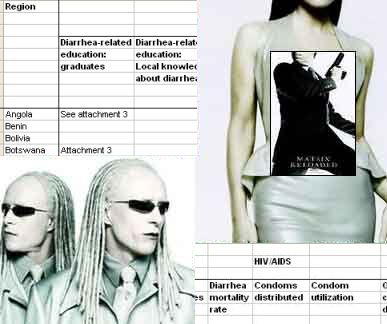We’re still right in the thick of things in Cause 1: we’ve received applications from about half our finalists and are still waiting on the other half. Two of those we received are causing me the most difficulty: Population Services International and UNICEF.
 PSI didn’t fill out our matrix, but it sent us their version. PSI measures the units of pills, condoms, bed-nets, etc. that they sell every year (giving us data back to 1999), and they match up volumes sold with research on disease prevalence, treatment efficacy, and expected utilization rates. That, combined with clear measures of how much they spend each year allows us to create a picture that’s clear about exactly what PSI is accomplishing.
PSI didn’t fill out our matrix, but it sent us their version. PSI measures the units of pills, condoms, bed-nets, etc. that they sell every year (giving us data back to 1999), and they match up volumes sold with research on disease prevalence, treatment efficacy, and expected utilization rates. That, combined with clear measures of how much they spend each year allows us to create a picture that’s clear about exactly what PSI is accomplishing.
UNICEF, because it’s so big – roughly 5 times the size of PSI, itself one of the largest non-profits out there – sent us a variety of reports, outcomes, and research papers, all of which just scratch the surface on UNICEF’s activities. But, what UNICEF gave us raises the question that their approach could be better.
UNICEF provided a top down picture of the biggest killers of children around the world, the priority places to implement their programs, and a fully-integrated approach to attacking all the barriers to healthy life facing African children. In one of the programs detailed, UNICEF provides full medical care to children in specific areas and then measures the impact on the villages it works in relative to other surrounding villages that don’t have the necessary services. UNICEF doesn’t just care for a subset of disease or conditions – they focus on a group of people and work to keep them healthy. While there’s a lot to be said for distributing cheap, effective medicine to needy people, given the complexity of problems and the multitude of diseases an approach based on people might be smarter.
But, then again, it’s hard to know because UNICEF is huge and only provided data for a couple programs that barely scratch the surface of the array of programs they run. Though we think UNICEF’s approach is smart, we have no idea what good we’re buying with our grant.
So what do we do? Even if Holden and I had the capacity to read aggregate and understand every report UNICEF has, they don’t have time to collect them all and send them to us. They just have too much information. So, you could argue that PSI can prove what they accomplish, and UNICEF can’t, so PSI is the better choice. But, neither Holden nor I likes the idea of awarding a grant because someone measures what they do. We want to pick the organizations that do the most good, and measurement is the best way to figure that out. We’ve got one organization giving us the whole story, and another giving us part of what might be a better one. Thoughts?

Comments
Reading this helped clarify my thinking about this battle of the mammoths. Basically, the issue is that we suspect UNICEF’s approach may be better, but we can’t do a straight comparison between “all of UNICEF” and “all of PSI.”
So why don’t we ask UNICEF to send us the full story on their activities in two different regions: one in which we would guess their approach would work better (i.e., a region where the conditions PSI ignores, pneumonia/perinatal conditions/etc., are major factors), and one in which we would guess that PSI’s would work better. Both regions should be very close/similar to areas where PSI is also working.
I think there’s a good chance that one org just has a better approach, and will be better in both regions. If not, we can figure out how much of Africa looks like the regions where PSI’s approach rules, and how much looks like the regions where UNICEF’s approach rules. It’s a very rough approach, but better than The Matrix Revolutions.
Comments are closed.